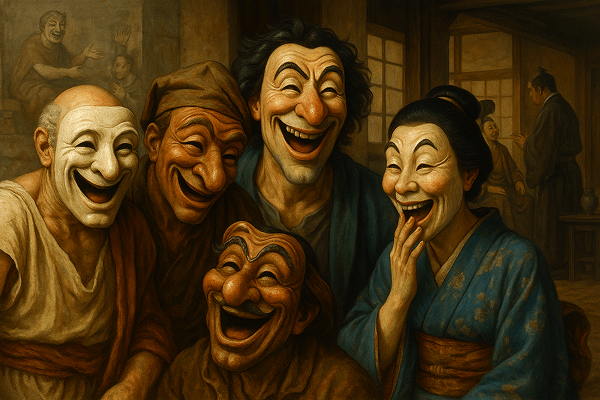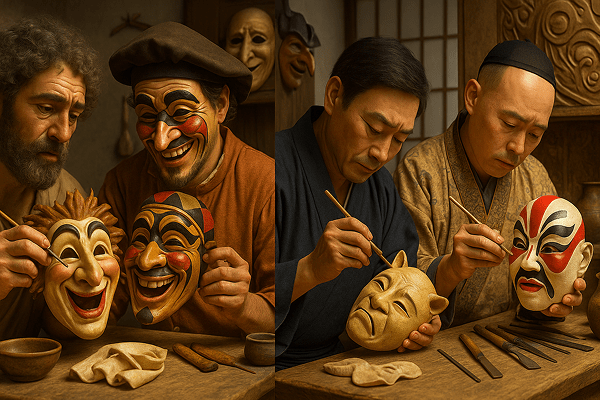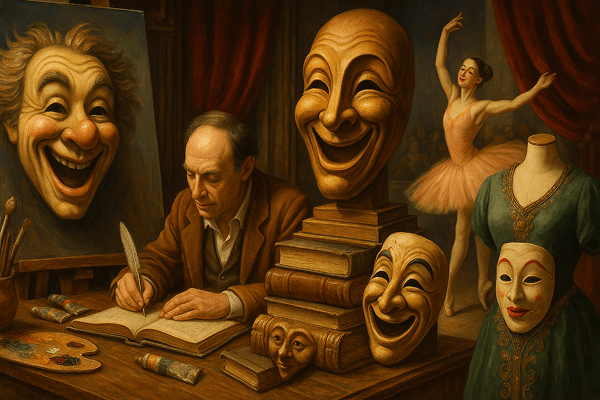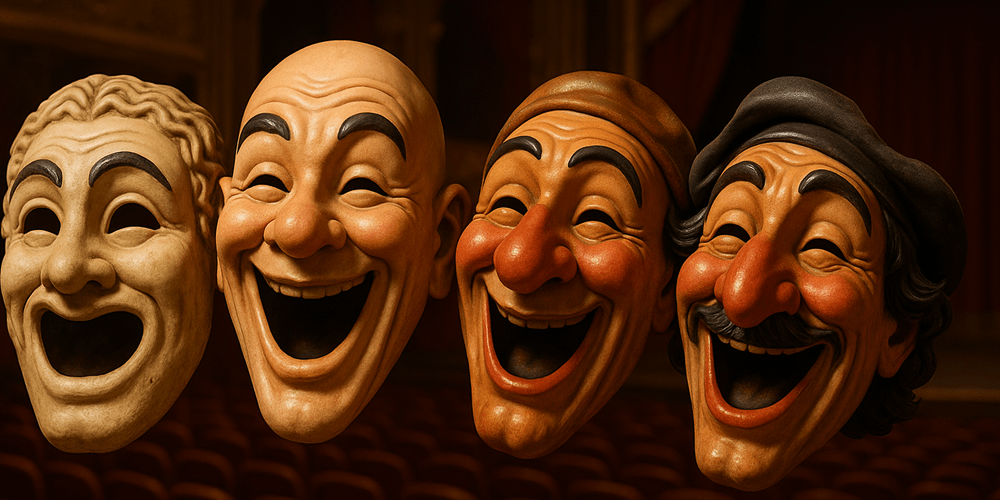Theatrical Comedy Masks are among the most iconic symbols in the world of performing arts, instantly recognized for their exaggerated, joyful expressions. Characterized by wide, open mouths, arched brows, and often bulbous noses or other humorous features, these masks are designed to evoke laughter and highlight the lighter side of human experience. Although closely associated with the ancient Greek theater, comedy masks have appeared in various forms in many cultures, including Roman, Italian Commedia dell’arte, Japanese Kyōgen, and beyond. Their origins trace back to some of the earliest traditions of staged entertainment, making them a cornerstone of theatrical history.
Historical Origins of Comedy Masks
The roots of Theatrical Comedy Masks can be traced to Ancient Greece, where the first documented use of masks in comedy dates back to the 5th century BCE. The Greek word for mask, “prosopon,” literally means “face” or “persona,” and comedy masks (komikos prosopon) were crafted to amplify the actor’s expressions and project them to large outdoor audiences. These masks were essential in Athenian festivals honoring Dionysus and became fundamental to the evolution of Western theater. Over time, Roman playwrights such as Plautus and Terence adopted and adapted the Greek tradition, further codifying the design and use of comedy masks.
The etymology of “comedy” comes from the Greek “komoidia” (κωμῳδία), meaning “revel-song.” Historical artifacts, including terracotta masks, vase paintings, and literary references from Aristophanes, provide evidence of the central role of masks in classical comedy. As theater traditions spread, the basic concept of the comedy mask evolved: in Commedia dell’arte, masks like Arlecchino and Pantalone emerged as visual shorthand for comic archetypes. In Japan, the Kyōgen mask tradition offered similar visual cues for humorous characters in contrast to the solemnity of Noh.
Cultural Significance and Symbolism of Comedy Masks
In every culture, Theatrical Comedy Masks symbolize joy, satire, and the power to challenge authority through humor. In ancient Greece, comedy was a vehicle for social commentary, using masks to lampoon politicians, philosophers, and daily life. The masks allowed actors to mock powerful figures without fear of retribution. Religiously, the laughter induced by comedy masks was seen as a form of release and renewal, contributing to the cathartic function of theater.

Legends and myths often surround the use of comedic masks. In Italy, Commedia dell’arte masks became associated with the carnivalesque, a time when social order was subverted, and servants could outwit their masters. In Japan, Kyōgen masks enabled actors to poke fun at samurai and priests, reflecting the underlying tensions of feudal society. Socially, comedy masks have always provided a safe space for critique, play, and the exploration of taboo subjects, making them a vital tool for both entertainment and cultural reflection.
Materials and Crafting Techniques of Comedy Masks
The making of Theatrical Comedy Masks is a refined craft, blending traditional skills with functional requirements. In Ancient Greece and Rome, masks were constructed from lightweight materials such as linen, cork, or wood, then painted and fitted for comfort and projection. Artisans sculpted prominent features — large mouths, exaggerated eyes — to ensure visibility and clarity from the stage to the highest seats.
In Italy, Commedia dell’arte comedy masks are typically made from leather, shaped wet over wooden molds, and finished with pigments and oils to create a durable, expressive surface. Japanese Kyōgen masks, carved from blocks of wood, are painted with natural pigments and often coated in lacquer for sheen and protection. Color choices are symbolic: vivid reds and yellows convey vitality and laughter, while bold outlines enhance comic effect.
- Chisels and knives for wood carving (Japan, Greece)
- Clay and plaster molds for leather masks (Italy)
- Layering of gesso and pigment for smooth finishes
- Decorative additions: feathers, mustaches, or painted wrinkles for comic exaggeration
Regional differences exist in both process and style. Italian masks often feature ornate details and bright colors, while Japanese masks are more restrained, relying on subtle carving and minimal color. The result is a dazzling variety of comedy masks, each crafted to reflect the humor and spirit of its culture.
Functions and Uses of Theatrical Comedy Masks
Theatrical Comedy Masks have served a wide array of functions throughout history:
- Ritual and ceremony: In ancient Greece, comedy was part of religious festivals, believed to please Dionysus.
- Theatrical performance: Masks allowed actors to play multiple roles, improvise, and amplify comedic timing.
- Festivals and public celebrations: In medieval and Renaissance Europe, masked comic performances were central to carnivals and public feasts.
- Social critique: Comedy masks provided anonymity, enabling actors to lampoon authority and address sensitive topics.
Over time, the use of comedy masks has adapted to changing contexts. While their ritual function has waned, they remain popular in theater, parades, and educational programs. In modern times, comedy masks appear in street theater, political satire, television, and even therapy, proving their continued relevance.
Regional Variations in Comedy Masks
Theatrical Comedy Masks display remarkable diversity across cultures:
- Greek and Roman: Broad smiles, bulbous noses, and wild hair, often painted in bright colors.
- Italian Commedia dell’arte: Each character — Arlecchino, Brighella, Pantalone — has a unique mask, with detailed expressions and symbolic features.
- Japanese Kyōgen: Subtle, stylized, often evoking animals or fools, with restrained yet expressive carving.
- Chinese Opera: Comic masks feature exaggerated eyes and mouths, sometimes painted directly on the face.
Local workshops and schools add further variety. In Venice, mask-makers develop their own interpretations of comic archetypes. In Kyoto and Osaka, Kyōgen masks reflect regional acting traditions. These variations highlight the adaptability and creativity of theatrical comedy masks, as well as their deep connection to community identity.

Famous Examples and Collections of Comedy Masks
Several renowned museums and collections house iconic Theatrical Comedy Masks:
- British Museum (London): Ancient Greek and Roman comedy masks, terracotta and marble.
- Museo Internazionale della Maschera Amleto e Donato Sartori (Italy): Commedia dell’arte masks, including original works by master mask-makers.
- Kyoto National Museum (Japan): Kyōgen masks, scripts, and performance costumes.
- Private collections: Rare and antique masks, often passed down through theatrical families or artisan workshops.
Notable historical finds include:
- Ancient Greek vases depicting masked comic actors
- Roman mosaics and frescoes
- 16th-century Italian masks preserved in theater archives
Online galleries like toddmasks.com provide virtual access to many of these treasures, along with educational resources for enthusiasts and researchers.
Influence of Comedy Masks on Art and Culture
Theatrical Comedy Masks have profoundly influenced global art and performance. Their bold forms inspired modernist painters like Picasso and Matisse, and their archetypal characters appear in literature from Shakespeare to contemporary satire. In cinema and television, the “comedy mask” remains a universal icon for humor and entertainment.
Their impact extends to:
- Visual arts: Depictions in paintings, sculpture, and street art
- Literature: From Aristophanes and Plautus to Cervantes and Goldoni
- Music and dance: Opera buffa, ballet, and contemporary musicals
- Fashion and design: Motifs in couture, jewelry, and graphic arts
Comedy masks also play a key role in the preservation of cultural heritage. Festivals, parades, and school programs keep the tradition alive, while ToddMasks and other institutions document and promote their ongoing relevance.

Contemporary Status and Preservation of Comedy Masks
Today, the tradition of Theatrical Comedy Masks is upheld by master artisans, theater companies, and cultural organizations worldwide. In Italy, workshops like those of the Sartori family continue to handcraft leather masks, while in Japan, Kyōgen schools maintain the art of comic performance and mask-making. Museums, universities, and online platforms such as toddmasks.com support research, training, and public engagement.
Modern adaptations and innovations include:
- Use of new materials: plastics, 3D printing, and digital design
- Integration with film, television, and digital media
- Educational programs and masterclasses for new generations
Efforts to balance authenticity with accessibility — such as certification of artisan masks and collaborative international projects — ensure that comedy masks remain vital and respected in the 21st century.
Collecting and Acquiring Comedy Masks
The market for Theatrical Comedy Masks ranges from affordable reproductions to invaluable antiques. Collectors can find authentic masks in:
- Artisan workshops (Italy, Japan, France)
- Museum shops and international galleries
- Reputable online platforms like toddmasks.com
Key factors influencing value include:
- Age and provenance
- Artisan or workshop reputation
- Condition and materials
- Cultural significance and rarity
To ensure authenticity and ethical collecting:
- Obtain documentation or certificates of origin
- Support living artisans and fair trade
- Respect sacred or restricted masks, avoiding illegal or exploitative sales
Theatrical Comedy Masks are more than props — they are living symbols of joy, satire, and the transformative power of laughter. From ancient rituals to modern stage and screen, these masks continue to inspire, unite, and challenge audiences around the world. As new generations discover their magic, supported by experts and resources like toddmasks.com, the tradition of comedy masks promises to remain vibrant for centuries to come.
